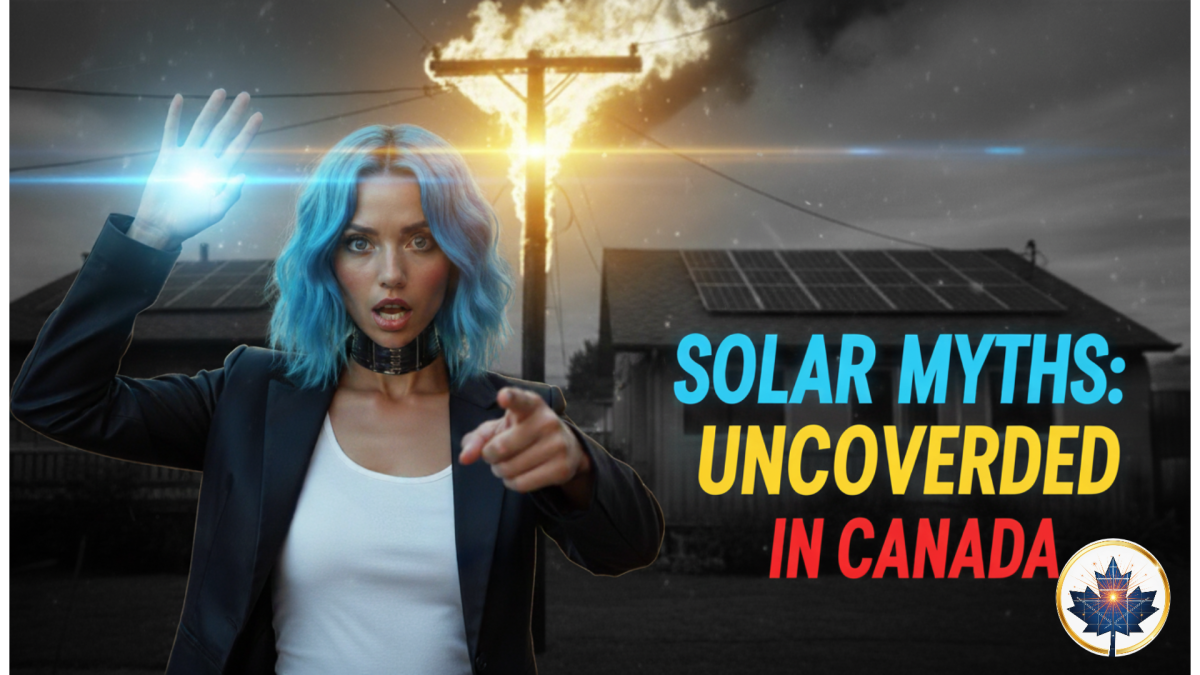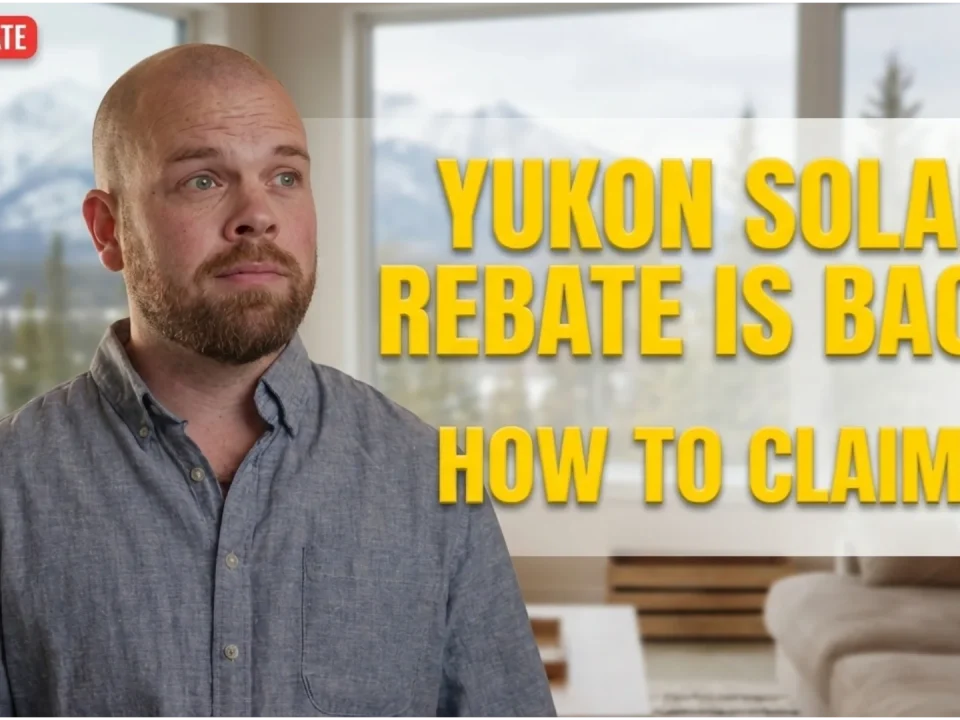
Solar Panels Dartmouth: 2025 Prices, Rebates, and Best Companies
September 8, 2025
Do Solar Panels Pay For Themselves in Canada? Provincial Rating
September 10, 2025That number on your latest hydro bill stings, doesn’t it? If you’re wondering whether solar panels are a real solution or just hype, you’re asking the right questions. It’s a big financial decision, and you’re smart to be skeptical. There’s a ton of information floating around—and frankly, a lot of it is outdated or just plain wrong.
I’m Vitaliy. For over a decade at SolarEnergies.ca, I’ve been helping Canadians separate the facts from the fiction in home energy. My goal isn’t to sell you a system; it’s to give you the straight goods so you can make a decision that’s right for your wallet and your home. Let’s tackle the 15 biggest myths I hear all the time and see what the data actually says for 2025.
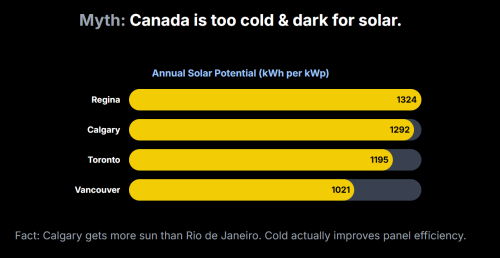
Myth 1: Canada Is Too Cold and Dark for Solar
This is the classic Canadian objection. It feels true, but the numbers tell a different story.
The Facts on Sunlight and Temperature
Solar panels generate electricity from light, not heat. In fact, they work more efficiently in colder temperatures. Extreme heat creates resistance and reduces a panel’s output. Those crisp, sunny winter days? They’re fantastic for solar production.
Many parts of Canada get a surprising amount of sun. According to Natural Resources Canada, Calgary gets more annual solar radiation than Rio de Janeiro, and Toronto sees more sun than Rome. The prairies are a solar goldmine.
Annual Solar Potential of Canadian Cities (kWh/kWp) This table shows how many kilowatt-hours (kWh) a 1-kilowatt peak (kWp) solar panel system can be expected to generate in a year.
| City | Expected Annual Generation (kWh) |
|---|---|
| Regina, SK | 1324 |
| Calgary, AB | 1292 |
| Winnipeg, MB | 1277 |
| Toronto, ON | 1195 |
| Montréal, QC | 1150 |
| Halifax, NS | 1118 |
| Vancouver, BC | 1021 |
Source: SolarEnergies.ca
These numbers are more than enough to make solar a viable energy source across most of the country.
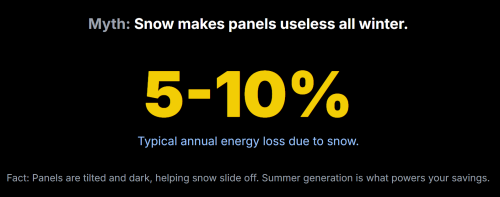
Myth 2: Snow Makes Panels Useless All Winter
A valid concern. If panels are buried in snow, they can’t see the sun.
The Reality of Snow
Snow isn’t the deal-breaker you might think. First, panels are installed at a tilt, and their dark, smooth surface helps snow slide off once the sun appears. Second, winter days are shorter anyway, meaning winter generation is a smaller piece of your total annual production pie.
Research from the Northern Alberta Institute of Technology (NAIT) shows that annual energy losses due to snow are typically in the range of 5-10%. While you can clear them, it’s often not worth the risk. The energy you generate from May to October is what powers your savings.
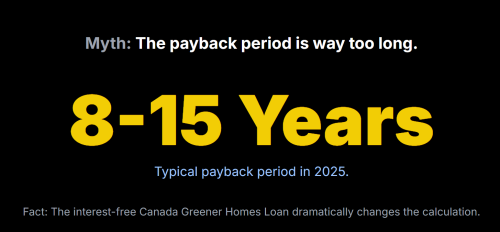
Myth 3: The Payback Period Is Way Too Long
This is where the rubber meets the road. Solar is an investment, and you need to know when it will pay you back.
Breaking Down the 2025 Numbers
The upfront cost of a residential solar system in Canada ranges from $15,000 to $30,000. That’s a serious number. But the federal Canada Greener Homes Loan changes the math completely. It offers up to $40,000 interest-free for 10 years.
Let’s look at a typical 8 kW system costing $20,000 in Ontario.
- Your monthly loan payment: $167 (interest-free).
- Your estimated monthly hydro savings: ~$120 (based on 9,600 kWh/year at $0.15/kWh).
For a net cost of about $47 a month, you’re building equity in an asset that eliminates your hydro bill after 10 years. Once the loan is paid, you get 15+ years of free electricity. Since hydro rates increase almost every year, your savings grow and this payback period often shortens over time. Note: This is an Ontario-based example. Your exact savings in Alberta, BC, or Nova Scotia will vary with local electricity rates and sunshine, but the financial principle remains the same.
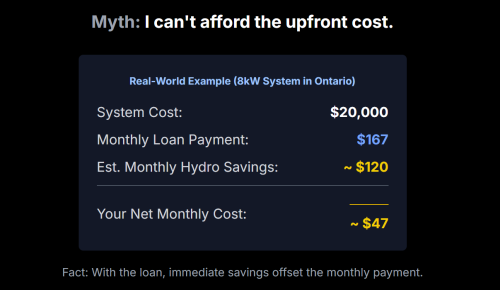
Myth 4: Solar Panels Need Constant, Expensive Maintenance
People picture complex machines that need constant tinkering. The truth is much simpler. Solar panels have no moving parts. They are built to withstand Canadian weather for 25-30 years. Your main job? Let the rain wash them. If they get really dirty, you might hose them down once a year. That’s it. The inverter might need replacing once in the system’s lifetime, but that’s a predictable future cost, not a regular maintenance bill.
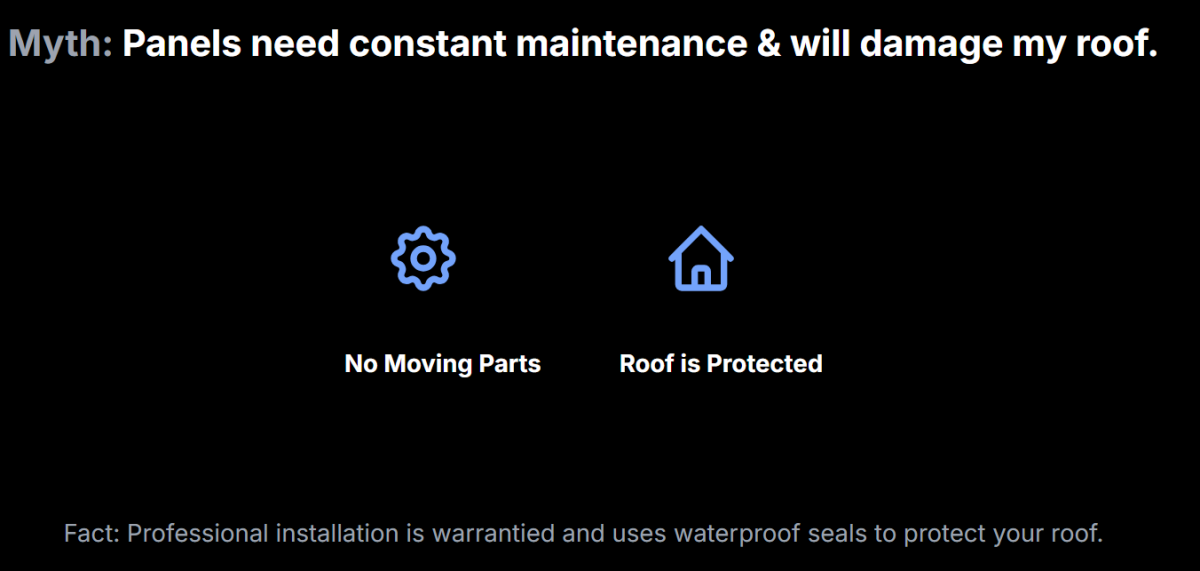
Myth 5: Solar Panels Will Damage My Roof
No one wants to trade clean energy for a leaky roof. This fear is understandable but misplaced if the job is done right.
How Professional Installation Works
Installers use specialized mounting systems with flashing—metal plates that slide under your shingles—to create a waterproof seal around every penetration point. These systems are engineered to protect your roof’s integrity. A reputable installer provides a warranty on their workmanship, covering any potential roof issues. Before anything is installed, they must perform a structural assessment to ensure your roof can handle the load.
Tip for Peace of Mind: Ask your installer for details on their mounting hardware and their workmanship warranty. A professional will be happy to show you how they protect your roof.
Myth 6: I Need a Perfect, South-Facing Roof
A south-facing roof is ideal, but it’s far from the only option. East- and west-facing roofs are very effective. An east-facing array will generate more power in the morning, while a west-facing one will peak in the afternoon. A system split between east and west can provide a broader, more consistent production curve throughout the day, which can be great for self-consumption. The overall annual production might be 10-15% less than a perfectly south-facing roof, but it’s still highly viable.
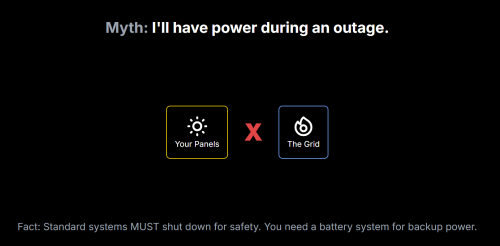
Myth 7: Panels Will Power My Home During an Outage
This is a dangerous misconception. Standard grid-tied solar systems are required by law to shut down during a power outage. This is a safety feature to prevent your panels from sending electricity back to the grid and potentially harming utility workers trying to fix the lines. If you want backup power, you need to add a battery storage system or a special inverter with that capability.
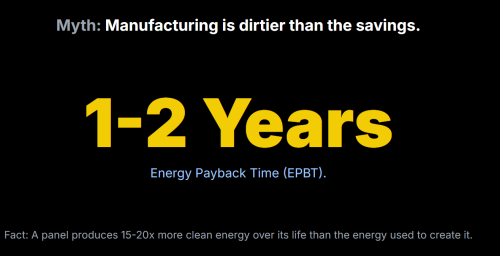
Myth 8: Manufacturing Panels Creates More Pollution Than They Save
This is a myth rooted in old data. The energy and carbon footprint of manufacturing has dropped dramatically. The key metric is Energy Payback Time (EPBT)—the time it takes for a panel to generate the same amount of energy that was used to produce it. Studies from institutions like Germany’s Fraunhofer Institute for Solar Energy Systems show that for modern panels, the EPBT in a location like Southern Canada is between 1 and 2 years. To put it simply: a panel uses the first 1-2 years of its life to ‘pay back’ the energy debt from its creation. For the next 25+ years, it’s a net energy producer, delivering a massive surplus of clean power.
Myth 9: I Need to Go Completely Off-Grid
Going off-grid is expensive and impractical for most people. It requires a massive battery bank to get you through the night and cloudy winter weeks. The best solution for 99% of homeowners is a grid-tied system with net metering. This program allows you to send your excess solar energy to the grid for a credit. At night or in the winter when you aren’t producing enough, you draw power from the grid, using up your credits. It effectively uses the grid as your battery, without the cost.
Myth 10: The Technology Is Changing Too Fast, I Should Wait
Waiting for the “next big thing” in tech is a common thought. But solar panel technology is mature. Efficiency gains are now incremental, not revolutionary. A panel today might be 21% efficient, and in five years it might be 23%. The small gain in efficiency you get by waiting is almost always erased by the money you spend on electricity in those five years. The best time to start saving is now.
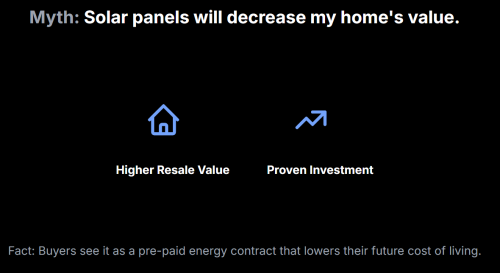
Myth 11: Solar Panels Will Decrease My Home’s Value
The opposite is proving to be true. Studies in the U.S. by organizations like the Lawrence Berkeley National Laboratory have consistently found that homes with solar panels sell for a premium. While the Canadian market data is still emerging, the Appraisal Institute of Canada recognizes that solar installations can add value. Buyers see it as a pre-paid energy contract that lowers their future cost of living. When you sell, be sure to provide documentation of your system’s installation and your average monthly hydro savings; this gives appraisers and buyers concrete data to factor into the home’s value.
Myth 12: You Can’t Recycle Solar Panels
This is becoming less true every day. Solar panels are made of glass, aluminum, and silicon—all highly recyclable materials. While Canada’s recycling infrastructure is still developing, regulations are being put in place. Organizations like the Canadian Renewable Energy Association (formerly CanSIA) are working on end-of-life management programs. You won’t be sending your panels to a landfill in 25 years; a dedicated recycling industry is ready to reclaim those valuable materials.
Myth 13: All Solar Panels Are Created Equal
The brand and quality of your panels matter. Tier-1 manufacturers are large, bankable companies with a proven track record of honoring their 25-year performance warranties. Cheaper panels from unknown brands might save you money upfront but could degrade faster or leave you with a worthless warranty if the company disappears. Your installer should be transparent about the brands they use and why.
Myth 14: Government Incentives Are Too Hard to Get
Navigating bureaucracy is no one’s idea of fun. But your installation company does almost all the work for you. They handle the permitting, the utility interconnection application, and they will guide you step-by-step through the Canada Greener Homes Loan application. They have done it hundreds of times and know exactly what paperwork is needed.
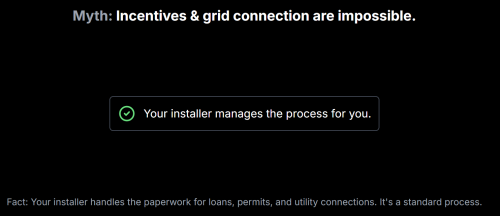
Myth 15: My Local Utility Will Make It Impossible to Connect
Utilities across Canada have standardized processes for connecting solar systems to the grid. It’s called an interconnection agreement, and it’s a routine part of the process. Your installer files the application, the utility reviews the plan to ensure it meets safety standards, and then they give permission to operate. It’s a regulated, routine procedure—not an adversarial fight.
The Bottom Line for 2025
Look, going solar isn’t a magic bullet. It’s a calculated investment. But the decision should be based on today’s technology and today’s financial realities, not on myths from ten years ago. Your first step isn’t to sign a contract; it’s to get information. Contact two or three certified local installers and ask for a detailed quote. This will give you the real numbers for your specific roof and hydro usage—no obligation. Armed with facts, you can decide if it’s the right move for you.

